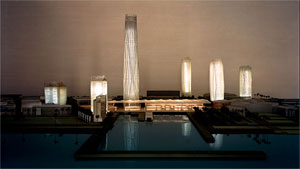Every day, a few hundred thousand vehicles cross the San Francisco-Oakland Bay Bridge, their drivers barely aware of the small, rectangular land mass lying just to the north. From where I am standing, on rocky Yerba Buena Island, I can both hear the traffic thundering overhead and look across a narrow isthmus to the long-forgotten patch of real estate in the middle of the bay: Treasure Island. Home to an abandoned Navy base and a small population of low- to middle-income residents, the 400-acre property hardly lives up to its prosperous name. Defunct military buildings, rusty oil tanks and electrical transformers litter the landscape. Crumbling asphalt caps chemical dumps.
Treasure Island is an unlikely place to look for the city of the future, but that's what I'm here to find. My guide is Jean Rogers, an environmental engineer with the global design and consulting firm Arup. Surrounded by a panorama of postcard views—San Francisco, Golden Gate, Berkeley Hills—and buffeted by winds that whip in from the Pacific, Rogers seems somewhat unlikely, too: Petite, stylish, with an impressive string of degrees and a down-to-business manner, she speaks with easygoing "likes" and "you knows" sprinkled among phrases such as "tertiary water treatment" and "optimal solar exposure." Rogers jabs at the ground with the heel of her shoe, reminding me what an engineering feat we stand on: Completely man-made, Treasure Island consists of 20 million cubic yards of sea bottom that has been dredged up, dumped into walls made of 287,000 tons of quarried rock and topped with 50,000 cubic yards of loam.
Built for the Golden Gate International Exposition in 1939, Treasure Island was claimed as a Naval base during World War II. When the base was finally decommissioned 11 years ago, San Francisco began studying how to redevelop it. From nearly 300 meetings among city officials, engineers, architects and the public emerged a plan for the most ambitious new community in the United States—a 13,500-person "urban oasis" that will rise from the soil of reclaimed Superfund sites, combining cutting-edge technology with restored natural systems to leave a light footprint on the Earth. After ground is broken in 2009, Treasure Island will become a testbed for the newest ideas in energy efficiency, water conservation, waste management and low-impact living. Says Rogers, with idealism undaunted by the task ahead: "We want it to be the most ecological city in the world." Read


